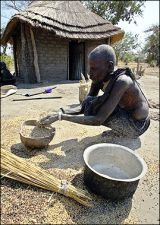Basic infrastructure lacking as thousands return to south Sudan
NAIROBI, Feb 21, 2005 (IRIN) — Thousands of displaced Sudanese have
returned to the south following the signing in January of a comprehensive
peace agreement, but the region totally lacks basic infrastructure, a UN
official said.

|
|
A woman in the southern Sudanese town of Rumbek cleans grain. (AFP). |
“An estimated 600,000 Sudanese have already returned home spontaneously,”
Wendy Chamberlin, UNHCR deputy high commissioner, told reporters in the
Kenyan capital, Nairobi, on Friday.
“Over 200,000 were non-registered refugees from Uganda, the DRC
[Democratic Republic of Congo] and Kenya and perhaps as many as 400,000
were IDPs [internally displaced persons] who returned on their own,” she
said.
Thousands more, she added, were expected within the next few months.
The returnees were, however, arriving in an area lacking basic
infrastructure – from roads, schools, clinics and buildings for the local
civil authorities, to protection for the returnees.
“UNHCR does not encourage people to return without assistance or without
information about the situation in their return destination,” Chamberlin
said. “UNHCR is trying to prepare the ground by implementing
community-based programmes in the fields of water, health, education and
landmine clearance.”
She added: “UNHCR is in a race against time to get adequate conditions in
place for the Sudanese refugees and IDPs who are anticipated to return
within the next few months.”
However, the agency said it needed more support. Of the nearly US $30
million it requested for operations in southern Sudan in 2004, only about
$6 million was received. To create conditions conducive for the current
returnees, UNHCR needs more than $40 million, but had only received $4-5
million so far, Chamberlin said.
“The international community has a window of opportunity [since the
January peace agreement] to put infrastructure in place so that people
could begin returning home,” she told reporters.
The agreement was signed on 9 January in Nairobi between the government
and the Sudan People’s Liberation Movement/Army (SPLM/A), ending 21 years
of war that devastated southern Sudan. It raised the hopes of hundreds of
thousands of displaced Sudanese that they would be returning home soon.
Chamberlin, who was in Kenya as part of a weeklong mission that included
Sudan and Uganda, said she aimed to focus attention on the impending
repatriation of some 560,000 Sudanese refugees.
Demonstrating the complexities of facilitating the return of large groups
of people after decades of war, Chamberlin said she had met young girls in
refugee camps in Uganda and Kenya who were concerned about the lack of
protection from early marriage when they would return.
“The issue has been raised with other UN and NGO partners, and UNICEF [UN
Children’s Fund] is currently working with the SPLM/A on child protection
legislation,” she said.
In southern Sudan, she visited the towns of Rumbek and Yei where she saw
some of the enormous rehabilitation needed to rebuild this strife-torn
region. Chamberlin said another urgent need she had identified in the
region was landmine clearance. The roads themselves were in poor condition
as well.
The conflict in the south has also displaced an estimated four million
more people within Sudan and killed an estimated two million.
The war between the SPLM/A and the Sudanese government erupted in 1983
when the rebels took up arms against authorities based in the north to
demand greater autonomy. The peace agreement was reached after more than
two years of talks brokered by the regional Intergovernmental Authority on
Development and hosted by Kenya.
